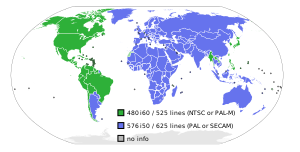
Standard-definition television
Digital television with a similar definition to legacy analog systems / From Wikipedia, the free encyclopedia
Dear Wikiwand AI, let's keep it short by simply answering these key questions:
Can you list the top facts and stats about SDTV?
Summarize this article for a 10 years old
Standard-definition television (SDTV, SD, often shortened to standard definition) is a television system that uses a resolution that is not considered to be either high or enhanced definition.[1] "Standard" refers to offering a similar resolution to the analog broadcast systems used when it was introduced.[1][2]

The two SDTV signal types are 576i (with 576 interlaced lines of resolution,[3] derived from the European-developed PAL and SECAM systems), and 480i (with 480 interlaced lines of resolution,[4] based on the American NTSC system). SDTV refresh rates are 25, 29.97 and 30 frames per second, again based on the analog systems mentioned.
SDTV originated from the need for a standard to digitize analog TV (defined in BT.601) and is now used for digital TV broadcasts and home appliances such as game consoles and DVD disc players.[4][5]
Standards that support digital SDTV broadcast include DVB, ATSC, and ISDB.[6] The last two were originally developed for HDTV, but are also used for their ability to deliver multiple SD video and audio streams via multiplexing.
Digital SDTV broadcast eliminates the ghosting and noisy images associated with analog systems. However, if the reception has interference or is poor, where the error correction cannot compensate one will encounter various other artifacts such as image freezing, stuttering, or dropouts from missing intra-frames or blockiness from missing macroblocks.[lower-alpha 1]
In North America, digital SDTV is broadcast in the same 4:3 aspect ratio as NTSC signals, with widescreen content often being center cut.[6]
In other parts of the world that used the PAL or SECAM color systems, digital standard-definition television is now usually shown with a 16:9 aspect ratio, with the transition occurring between the mid-1990s and late-2000s depending on the region. Older programs with a 4:3 aspect ratio are broadcast with a flag that switches the display to 4:3.[lower-alpha 2]